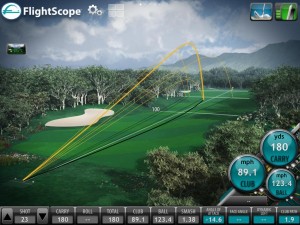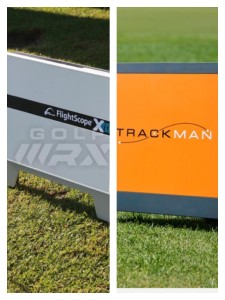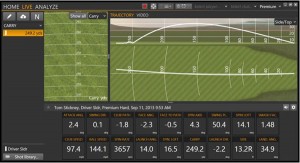What Launch Monitors can tell you (and me)

I have worked with all the technologies that have come along in my many years as a golf instructor in an effort to make my job much easier.
In the beginning I only used my eyes. Then digital video came along, followed by 3D Motion analysis that showed me every nuance of the body during the swing. And now Doppler radar launch monitors like FlightScope and Trackman can show me the actions of the club and ball flight. I have always loved technology and the data it produced, and have thoroughly enjoyed my time using my Trackman. But I try not to teach in a numerical or technical way, because I get asked what this number means or what that number means. I love that many of the students I teach want to know everything, however, 99 percent of the time I will not explain the numbers during a lesson because I don’t want to confuse them. My job is to make things simpler, not more complex!
In this article, I thought it would be neat to explain to golfers what each of the numbers that Doppler radar launch monitors tell me about a golfer’s overall motion. I am going to explain MOST of the numbers, but not everything that systems like FlightScope and Trackman can show me. For more detailed and/or scientific definitions of the terms below, please see Trackman’s website.
Different instructors like to see things a different way, and thus they set their home screens up accordingly. With the help of Michael Pinkey, Trackman’s PGA Tour and LPGA Tour rep, I have set my data parameters up as shown below.
Attack Angle
Angle of attack shows whether golfers are hitting up, level or down on the golf ball at impact. Amateur golfers usually have attack angles that are more up with drivers, and down with hybrids and irons for the most part. A golfer’s angle of attack is a big key because it can help golfers get more distance with their driver (most players hit too much down), and correlates with the swing’s direction. That shows a golfer his or her true path at impact. The more golfers hit down on a golf ball, the more it skews their path to the right. The more golfers hit up on a golf ball, the more their path will move to the left. This is one of the most important instructional discoveries in golf to date.
Swing Direction
This is the general “direction of the swing,” and shows whether the club is moving from in-to-out, down-the-line or out-to-in through impact. However, it is NOT a golfer’s swing path! Swing direction correlated with a golfer’s angle of attack determines the “true swing path” during impact.
I use a golfer’s swing direction to see how much he or she tends to swing in or out, because most people have a tendency to swing one way or the other. It tells me how a golfer’s angle of attack must change, or how much a golfer’s aim must be adjusted in order for the golfer to zero out his or her path. It also helps me to understand why a golfer’s angle of attack is what it is. Usually, the more exaggeration a golfer has within his or her swing direction, the more that golfer must alter his or her angle of attack.
Club Path
Club path is a golfer’s “true path” at impact. It takes into account a golfer’s angle of attack and his or her overall swing’s direction. The ONLY way to accurately gauge a golfer’s true swing path is to be able to see this correlation! Contrary to popular belief, divots do not show a golfer’s true swing path. In fact, divots are basically useless, as they also do not show golfers the starting direction, curvature or angle of attack. They are also not an accurate gauge of lie angle. I use a golfer’s club path coupled with his or her face angle to understand why the golfer has the curvature on the ball they do. Provided a centered hit, the ball will bend AWAY from the path. Remember, path does not determine a golf ball’s starting direction: face angle does.
Face Angle
A golfer’s face angle is where the face is pointing when he or she impacts the ball. Face angle determines roughly 75 to 80 percent of a golf ball’s starting direction, and it correlates with a golfer’s club path to curve the ball by tilting the ball’s spin axis right or left. The correlation of a golfer’s face-to-path ratio (as we will see below) is how the ball’s curvature is controlled. If golfer’s face angle is right of the path (provided center contact), the ball will curve to the right. And if a golfer’s face angle is left of the path, the ball will move to the left.
Now, here is where it can get tricky. If a golfer hits the ball off-center, gear effect will take over. If I see shots that that curve the opposite directions to the above rules, I know a golfer has hit the ball off-center.
Face to Path
The face-to-path relationship that on that all golfers want to master. Simply stated, the closer a golfer’s face and path are correlated to one another, the lower the spin axis will be with centered contact. Professionals strive to keep their face-to-path ratio very low so the ball does not curve too much either way, however, they understand how to change the relationship so that they can curve the ball more when they need to. When the face and the path diverge to any great degree, a golfer will generally hit shots that curve one way or another a great deal. Thus, I try and help my students understand this relationship so that they can control the curvature of the ball at all times.
Most amateurs tell me that their goal is to have the club path move from the inside to the outside slightly with the face OPEN to the target-line, but CLOSED to the path in order to create a slight “push draw.” The most common flaw is to have the face too closed relative to the path, thus creating a “pull draw:” a ball that starts at or left of the target and curves away from it.
Spin Axis
Every ball a golfer hits has some degree of backspin. The only way a ball can curve is to tilt its backspin on an axis that can be either “right” or “left.” The greater this “tilt” or spin axis, the more the ball will curve. This number tells me to what degree a golfer has tilted a golf ball’s “spin axis” and how much the ball should curve with everything else being equal.
Swing Plane
At address, each club has a certain lie angle that fits a golfer’s swing and body type (if they have been correctly fit) at impact. Changing this lie angle can influence impact points and/or the fitting of a golfer’s clubs if not taken into account. If a golfer returns the club shaft to a much higher angle than it sat at address, he or she will tend to leave the face open and hit the ball off the toe. If a golfer’s swing plane returns into the ball on a much flatter angle than what was established at address, then he or she will tend to hit the ball with a closed face off the heel.
Changing the address swing plane to a great degree at impact tends to be more of a swing issue rather than one that can be fixed by a fitting. However, if you have not taken the time to get fit, I would suggest you do so ASAP! See Golf Digest’s 100 Best Clubfitters for more information.
Spin Loft
A golfer’s spin loft is the difference between his or her angle of attack and the dynamic loft of the club delivered at impact. The greater the difference is between these numbers, the more the ball will spin (up to a certain point). The smaller the spin loft, the more exaggeratedly the D-plane will tilt, making a golf ball curve more. This is the reason why it’s easier for a golfer to curve a driver than a 6 iron. “Compression” can also measured by the spin loft of the club a golfer is using, as there are ranges that each club should fall into. The smaller the spin loft number, the greater the compression.
For those of you who desire more spin on your wedges, please instructor Andrew Rice’s story on how spin-loft affects your wedge play.
Smash Factor
A golfer’s smash factor is the correlation between the club-head speed he or she delivers at impact and the subsequent speed imparted to the ball when the it leaves the club. This gives a rough estimate of how “efficient” a golfer is at impact. Every 1 mph of club-head speed would allow a golfer to gain 1.5 miles per hour of ball speed with a driver in a perfect world. However, the higher a golfer’s spin loft, the lower his or her smash factor will be. Thus, shorter clubs tend to have a lower smash factor than the 1-to-1.5 ratio that a driver can have. I check this number more often when someone hits with longer clubs, while I focus more on spin loft for the shorter clubs.
Club Speed
Club speed measures how fast the club moving at impact. I’d like to see a golfer use the most club-head speed he or she can handle while keeping the same sequencing within the swing as it pertains to the kinematic sequence. When the club reaches an in-line condition with a gofler’s forward arm, the club begins to slow down. So if a golfer “casts” the club, his or her fastest club-head speed usually occurs well BEFORE impact. Basically, the faster a golfer can swing the club the more likely he or she is going to create more ball speed.
Ball Speed
Ball speed measures how fast the golf ball leaves the club. Factors that can influence a golfer’s ball speed can be simple things like impact point, swing direction and low-point control. Ball speed can help me to see how consistently a golfer delivers the club in efforts to maximize distance with a driver or control and distance with his or her irons. On a very rough scale with a driver, the average amateur has a ball speed of 115-to-125 mph, club pros have ball speeds of 155-to-160 mph, tour pros have ball speeds of 160-to-170 mph and long-hitting tour pros have ball speeds of 170 to 185 mph. The long drive guys can get into the 190-to-220 mph range, just to give you some perspective.
Spin Rate
A golfer’s spin rate shows me how much backspin her or she is imparting on the golf ball when it leaves the club. It is greatly influenced by spin loft (described above). Golfers should aim to see lower backspin values with their long clubs relative their wedges because that allows them to get more distance with the long clubs and more stopping power with their wedges. Sometimes I want to see golfers create more spin, other times I want to see them create less.
Launch Angle
Launch angle is a measure of the angle that a golf ball leave the club after impact. A good way to think about it is to relate it to the spraying of garden hose: you don’t want the water to come out flat, nor do you want it to come out too high. A golfer’s goal is for the water to leave the hose at an angle that allows it to carry the farthest distance possible. This is the same way the ball should leave the club for most shots.
My job is to ensure the ball is launching off the club correctly, i.e. correlating with the loft of the club, so golfers can maximize their distance output. One of the most forgotten aspects of launch angle is impact point and vertical gear effect. If golfers hit the ball too high on the face, vertical gear effect will increase launch angle and create less spin. Hitting the ball lower on the face will launch the ball lower with less spin.
Dynamic Loft
While it is important to launch the ball with certain conditions, golfers must also have control of the club face as it pertains to the actual loft that they deliver to the ball itself. If golfers have a sand wedge with 56 degrees of loft and “lean the shaft back” 10 degrees at impact, they have now created a golf club with 66 degrees of dynamic loft. Distance is a problem for most average golfers, and these type of golfers tend to add loft to their irons through impact by “flipping” their hands. Yardage is reduced accordingly. Coupling launch angle and dynamic loft helps me to determine if golfers are getting what they need from their driver and irons in the way of trajectory and yardage control.
Carry Distance
Everyone golfer needs to know how far the ball carries in the air, as well as their total distance output. It’s the most basic requirement of top-level golf. Amazingly, most golfers have no idea how far they carry the ball, and do not even come close to understanding what their limitations are. That’s why they tend to come up short on the golf course so often.
Professionals know to the half yard how far their clubs go, and they learn to play within those yardages. If they did not, they would never be able to manage themselves around the course optimally. Accurate carry distances have helped players improve their wedge play, because if golfers cannot control their launch angles, dynamic lofts and spin rates they will never have consistent distance control.
Launch Direction
Launch direction tells golfers if their ball began left, at, or right of their intended target. A golfer’s initial launch direction is controlled by the club face, NOT the club’s path. I like to use this number to understand what the face is doing relative to the path at impact. I also like to know just how far off target the ball begins so that I can correlated the aim, face and path of my student in efforts to create the shot shape and curvature amount the golfer desires.
Everyone has a shot they like to “see.” Some golfers want more curvature, while others want less. By monitoring the ball’s initial starting direction, I am better able golfers create the shot golfers are confident playing under pressure.
Side
The “side” number alerts me to the exact amount in feet that the ball finished right or left of the intended target. Some people like to see total curvature, but I am only interested in where the ball finishes. That’s because every player has a different amount they like to see the ball move in the air. If I can help my students hit the ball a certain distance, as well as control their side-to-side movement of the ball, then I am confident I can lower their handicap. It’s always nice to see if better positions and numbers actually cause the ball to go straighter.
Landing Angle
The angle at which the ball lands on the ground can make the ball stop dead or cascade forward. With the irons, most golfers desire more stopping power. With the driver, golfers mostly desire the ball to run after landing. The higher the descent angle, the less the ball will move forward after hitting the ground (with backspin being the same). Different course conditions require different set make ups, and a golfer’s landing angle is a huge part of how the ball reacts after landing that golfers need to know.
Conclusion
I hope by now you understand the true power of what FlightScope and Trackman tells me within one swing. As I have said previously, it’s not about “pleasing the machine,” but finding optimal parameters that golfers can use to play their best.
I love to say that the orange box is not watching you, it’s watching ME, making sure that I am doing the right thing in order to improve your swing. If I tell you the “right” thing, your numbers will improve, however, you will be the one that tells me if you can actually play from there. Thankfully we have some latitude as instructors to change your swing in different ways. The FlightScope and Trackman systems make sure I am always moving in the most efficient direction possible.
By Guest Contributor: Tom Stickney II


